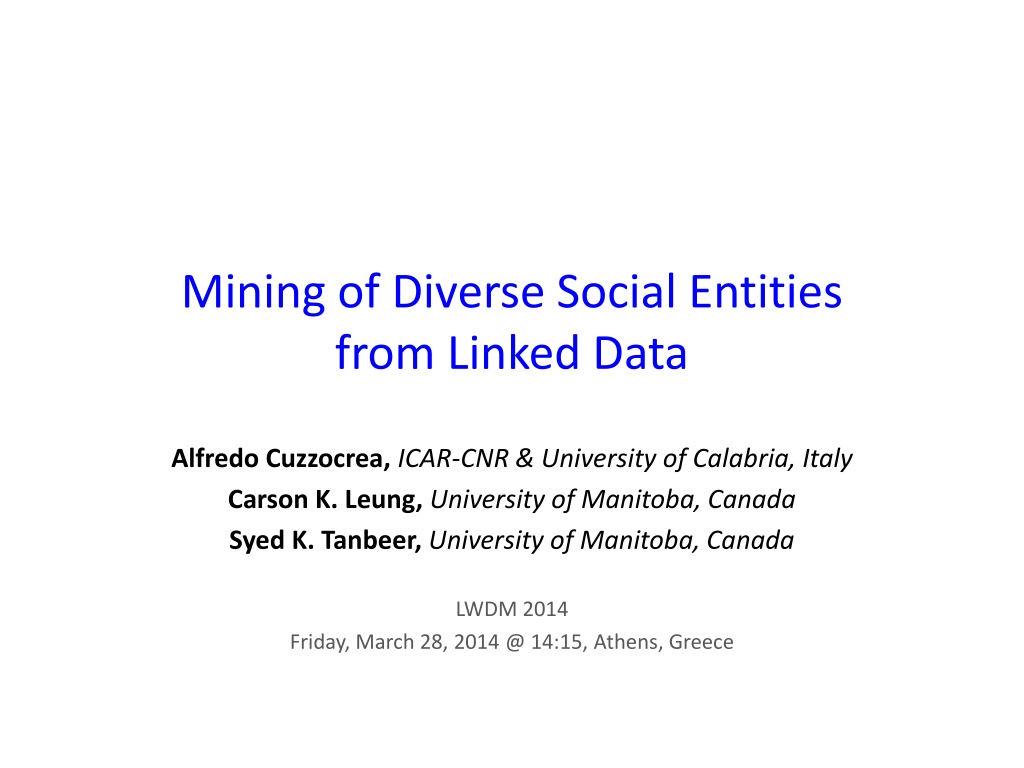Diverse Social Entities Mining from Linked Data in Social Networks
This research focuses on mining diverse social entities from linked data in social networks using a DF-tree structure and DF-growth mining algorithm. The study explores the extraction of important linked data in social networks and the mining of various social entities such as friends. Prominence values and frequencies are computed based on user-centric parameters like connectivity, centrality, and years of involvement, unveiling expertise and participation levels in different domains. The results demonstrate the significance of capturing diverse social entities in social networks for various applications.
Download Presentation

Please find below an Image/Link to download the presentation.
The content on the website is provided AS IS for your information and personal use only. It may not be sold, licensed, or shared on other websites without obtaining consent from the author. Download presentation by click this link. If you encounter any issues during the download, it is possible that the publisher has removed the file from their server.
E N D
Presentation Transcript
Mining of Diverse Social Entities from Linked Data Alfredo Cuzzocrea, ICAR-CNR & University of Calabria, Italy Carson K. Leung, University of Manitoba, Canada Syed K. Tanbeer, University of Manitoba, Canada LWDM 2014 Friday, March 28, 2014 @ 14:15, Athens, Greece
Outline Introduction & related work Our proposed DF-tree structure to capture important linked data in social networks DF-growth mining algorithm to mine diverse social entities (i.e., diverse friends) from linked social data Experimental results Conclusions Cuzzocrea et al. (EDBT/ICDT-LWDM 14) 2
Diverse Social Entities In a social network (e.g., LinkedIn), a social entity p (e.g., Georgios, Evgenios) may interest multiple domains E.g., list of 10 common-interest groups in 3 domains: Antonios, Barbara Computer Antonios, Barbara, Dimitrios Georgios, Dimitrios Barbara, Georgios, Dimitrios Barbara, Georgios, Evgenios Music Barbara, Hebe Georgios, Evgenios Antonios, Georgios Sports Antonios, Georgios, Evgenios Antonios, Zoe Cuzzocrea et al. (EDBT/ICDT-LWDM 14) 3
Diverse Social Entities Prominence value can be computed based on user-centric parameters (e.g., connectivity, centrality, years of membership, degree of involvement) reveals the level of expertise of p in each domain Antonios, Barbara Prom(Georgios, Computer) = 0.20 Georgios is a computer beginner Computer Antonios, Barbara, Dimitrios Georgios, Dimitrios Barbara, Georgios, Dimitrios Barbara, Georgios, Evgenios Prom(Georgios, Music ) = 0.60 Georgios plays music Music Barbara, Hebe Georgios, Evgenios Antonios, Georgios Prom(Georgios, Sports) = 0.70 Georgios is an athlete Sports Antonios, Georgios, Evgenios Antonios, Zoe Cuzzocrea et al. (EDBT/ICDT-LWDM 14) 4
Diverse Social Entities Frequency can be computed based on user s interest or commitment reveals level of participation of p in each domain Antonios, Barbara Freq(Georgios, Computer) = 1 Georgios participates in 1 common-interest group in computer Computer Antonios, Barbara, Dimitrios Georgios, Dimitrios Barbara, Georgios, Dimitrios Freq(Georgios, Music ) = 3 Georgios participates in 3 common-interest groups in music Barbara, Georgios, Evgenios Music Barbara, Hebe Georgios, Evgenios Antonios, Georgios Freq(Georgios, Sports) = 2 Georgios participates in 2 common-interest groups in sports Sports Antonios, Georgios, Evgenios Antonios, Zoe Cuzzocrea et al. (EDBT/ICDT-LWDM 14) 5
Diverse Social Entities Diversity measure based on both prominence value & frequency of a social entity across multiple domains (e.g., 3 domains) Cuzzocrea et al. (EDBT/ICDT-LWDM 14) 6
The DF-growth Algorithm: Mining Diverse Social Entities Key operations: 1. Construct a DF-treestructureto capture linked information (e.g., prominence value & frequency) of social entities 2. Mine potentially diverse social entities (based on upper bound to diversity) from the DF-tree in a tree-based divide-and-conquer fashion 3. Remove non-diverse social entities (i.e., keep only truly diverse social entities) Cuzzocrea et al. (EDBT/ICDT-LWDM 14) 7
Experimental Evaluation: Runtime Cuzzocrea et al. (EDBT/ICDT-LWDM 14) 8
Experimental Evaluation: Memory Cuzzocrea et al. (EDBT/ICDT-LWDM 14) 9
Experimental Evaluation: Scalability Cuzzocrea et al. (EDBT/ICDT-LWDM 14) 10
Conclusions We proposed: a notion of diverse social entities the DF-tree structure for capturing important information from linked data about social entities the DF-growth algorithm for mining social entities from linked social data captured in the DF-tree Cuzzocrea et al. (EDBT/ICDT-LWDM 14) 11
Future Work Conduct more extensive experimental evaluation on various linked data in social networks measure other aspects (e.g., precision) of our DF-growth algorithm Design a more sophisticated way to measure influence & diversity Incorporate other computational metrics (e.g., popularity, significance, strength) with prominence Cuzzocrea et al. (EDBT/ICDT-LWDM 14) 12
Thank you More info, please refer to our paper or contact us: dblab@cs.umanitoba.ca cuzzocrea@si.deis.unical.it Cuzzocrea et al. (EDBT/ICDT-LWDM 14) 13

























